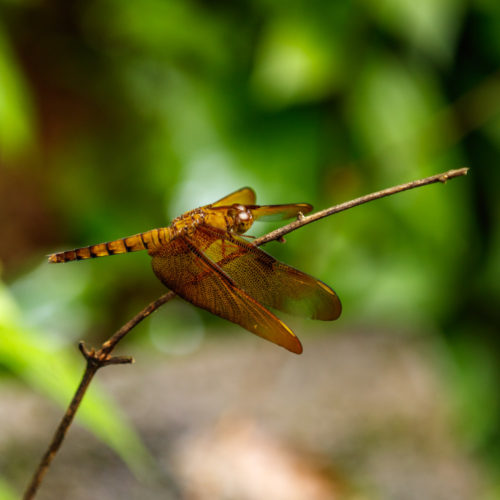
I found this female Fulvous Forest Skimmer (Neurothemis fulvia) dragonfly perched on a dry twig in our kitchen garden. It was a harsh August afternoon dappled sunlight falling over the dragonfly. Instead of using a macro lens I tried using a different strategy to capture dragonfly.

Since many dragonflies are wary of approach by humans, it is easier to capture them from a distance. My favourite lens for this was Canon EOS 300mm f/4 which had a very nice close focus distance and a perfect focal length. Nearest to that in my arsenal was 70-200mm lens. So I captured this skimmer with Canon EOS 5DS R fitted with Canon EF 70-200mm f/2.8L IS II USM and a Canon EF 1.4 III Extender. Canon EF 70-200mm f/2.8L IS II USM has a Minimum focus distance of 1.2 meters.

The 1.4x extender is also known as Tele-Converter as it magnifies the original lens by 1.4 times. A Tele-Converter does not affect the minimum focus distance of a lens. If you are looking for a solution that does decrease the MFD, then you need to employ extension tubes. Of course, Tele-Converters not only magnify your subject, but all of the optical aberrations as well. Lenses that are not great performers at MFD may not be good choices for use with a Tele-Converter up close. It’s also important to use a quality Tele-Converter that is a good match to your optics, so avoid mixing lens and Tele-Converter brands where possible. Here the Canon EF 70-200mm f/2.8L IS II USM and a Canon EF 1.4 III Extender was a match made in heaven. It gave me 280mm of resulting focal length and a great sharpness.

Fulvous Forest Skimmer (Neurothemis fulvia) is a medium sized rusty coloured dragonfly with transparent wing tips. Male is reddish brown whereas the female is paler brown in colour.

Male has a reddish brown face with eyes which are dark reddish brown above, golden brown below. Thorax, abdomen and legs are reddish browns. Wings are dark reddish brown with an irregular triangular transparent area at the tip of the wing. The wing spots are dark reddish brown.

Many forms of females are found. Color of head, thorax and abdomen paler than males or rusty brown. Wings are clear amber yellow with a dark ray extending to the tip in fore wing. Many of them have a irregular triangular transparent area at the tip of the wing.

It is a dragonfly of wet forests. Usually, perches on fallen logs and shrubs. A large number of them can be found together in canopy gaps and forest edges. However, during the wet season, they move out of forested areas to non-forested bits.

What was unusual with these specimens were that they lacked irregular transparent areas which are so characteristic of this type of dragonfly species.

It breeds in marshes associated with forest streams and rivers. They are found throughout the year. However, large number can be seen between May-September.



It’s real wonder, you have used 1.4x TC, it’s amazing Details and BG looks extraordinary. Beautiful Click and Wonderful Results.
Sir one of your Dragonfly looks Haze, Is it your creativity or it was something added up. But looks more good in slightly Blurred way.
Thanks in Advance.
Sir one of your Dragonfly looks Haze, Is it your creativity or it was something added up. But looks more good in slightly Blurred way.
Thanks in Advance.
ಎಷ್ಟು ಚಂದಕ್ಕೆ ತಲೆತಿನ್ತೀರಿ ಮಾರಾಯ್ರೇ. ನಾನು ಬಾಲ್ಯದ ನೆನಪುಗಳನ್ನಷ್ಟೇ ಹೆಕ್ಕಿ, ಅದರ ಬಾಲಕ್ಕೆ ದಾರ ಕಟ್ಟಿದ್ದು ವಿವರಿಸಿಬಿಡ್ತಿದ್ದೆ 🙂
??????? ??? ????? ???? ??????????. ?? ????????? ???????? ??????????. ???? ??? ??????? ????? ???? ???????? ????? ???? share ????????? ??? ???????? ??????
Dear Zameer, I used a leaf in front of the lens in out of focus foreground, purposely to get that hazy look. Here my intention is like I am a dragonfly standing behind this one (by the way it is female) To create the fuzziness of how the dragonfly will see its world I used a foreground leaf to be sort of filter to give a fuzzy world.